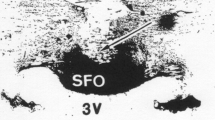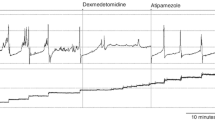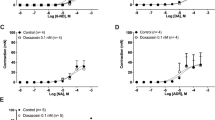Summary
This study was undertaken in an attempt to explain why in some of the tissues in which noradrenaline and ATP act as co-transmitters the noradrenergic component predominates, while in others the predominant component is purinergic. Four different tissues were used: the epididymal portion of the rat vas deferens and the rabbit ear artery, tissues where the noradrenergic component predominates, and the prostatic portion of the rat vas deferens and the rabbit jejunal artery, where the purinergic component predominates. The noradrenaline content as well as the electrically-evoked release of noradrenaline were determined in all tissues. To determine the evoked release, the tissues were pretreated with pargyline (1 mmol · 1−1) and then exposed to 3H-noradrenaline, washed out and transmurally stimulated (1 Hz). In addition, the influence of inhibition of neuronal uptake by desipramine (40nmo1·1−1) on pre- and postjunctional effects of adrenaline and α-methylnoradrenaline (and/or noradrenaline) was compared.
The noradrenaline content of the tissues averaged: 17.4, 23.2, 3.1, and 4.8 μg·g−1 for the epididymal and the prostatic portions of the rat vas deferens and for the ear and the jejunal arteries of the rabbit, respectively. The fractional electrically-evoked release of 3H-noradrenaline was 2.02 and 2.04 × 10−5 for the epididymal and the prostatic portions of the rat vas deferens, respectively, and 3.33 and 3.26 × 10−5 for the ear and the jejunal arteries of the rabbit, respectively. Desipramine enhanced much more the postjunctional effect of noradrenaline, adrenaline, and α-methylnoradrenaline in the epididymal than in the prostatic portion of the rat vas deferens. Moreover, desipramine similarly enhanced the effects of noradrenaline and adrenaline in the ear artery, while it did not modify the responses to these amines in the jejunal artery. The influence of inhibition of neuronal uptake on the prejunctional effect of sympathomimetic agonists was studied in the rat vas deferens only. Desipramine caused very marked and similar enhancements of the inhibitory effect of the amines in the epididymal and the prostatic portions (72.5 and 93.5 times, respectively, for adrenaline, and 34.7 and 41.4 times, respectively, for α-methylnoradrenaline).
These results are compatible with the hypothesis that postjunctional adrenoceptors are situated closer to the varicosities in the epididymal than in the prostatic portion of the rat vas deferens and also closer in the rabbit ear than in the rabbit jejunal artery. Therefore, the variation in the relative importance of the noradrenergic and the purinergic components may depend on the distance between the sites from where the transmitters are released and the sites where they act.
Similar content being viewed by others
References
Allcorn RJ, Cunnane TC, Kirkpatrick K (1986) Actions of α,β-methy-lene ATP and 6-hydroxydopamine on sympathetic neurotransmission in the vas deferens of guinea-pig, rat and mouse: support for co-transmission. Br J Pharmacol 89:647–659
Bulloch JM, Starke K (1990) Presynaptic α2-autoinhibition in a vascular neuroeffector junction where ATP and noradrenaline act as co-transmitters. Br J Pharmacol 99:279–284
Burnstock G (1990) Co Transmission. Arch Int Pharmacodyn 304:7–33
Cambridge D (1981) UK-14,304 a potent and selective α2-agonist for the characterization of a-adrenoceptor subtypes. Eur J Pharmacol 72:413–415
French AM, Scott NC (1983) Evidence to support the hypothesis that ATP is a co-transmitter in rat vas deferens. Experientia 39:264–266
Guimarães S (1982) Two adrenergic biophases in blood vessels. Trends Pharmacol Sci 3:159–161
Guimarães S, Osswald W (1969) Adrenergic receptors in the veins of the dog. Eur J Pharmacol 5:133–140
Guimarães S, Paiva MQ (1981a) Two distinct adrenoceptor biophases in the vasculature. One for α and the other for β-agonists. Naunyn-Schmiedeberg's Arch Pharmacol 316:195–199
Guimarães S, Paiva MQ (1981b) Two different biophases for adrenaline released by electrical stimulation or tyramine from the sympathetic nerve endings of the dog saphenous vein. Naunyn-Schmiedeberg's Arch Pharmacol 316:200–204
Guimarães S, Azevedo I, Cardoso W Oliveira MC (1975) Relation between the amount of smooth muscle of venous tissue and the degree of supersensitivity to isoprenaline caused by inhibition of catechol-O-methyl transferase. Naunyn-Schmiedeberg's Arch Pharmacol 286:401–412
Hirst GDS, Neild TO (1980) Evidence for two populations of excitatory receptors for noradrenaline on arteriolar smooth muscle. Nature 283:767–768
Itoh T, Kitamura K, Kuriyama H (1983) Roles of extrajunctional receptors in the response of guinea-pig mesenteric and rat tail arteries to adrenergic nerves. J Physiol (Lond) 345:409–422
Kennedy C, Saville VL, Burnstock G (1986) The contributions of noradrenaline and ATP to the responses of the rabbit central ear artery to sympathetic nerve stimulation depend on the parameters of stimulation. Eur J Pharmacol 122:291–300
Kuriyama H, Makita Y (1983) Modulation of noradrenergic transmission in the guinea-pig mesenteric artery: an electrophysiological study. J Physiol (Lond) 335:609–627
Kuriyama H, Suyama A (1983) Multiple actions of cocaine on neuromuscular transmission and smooth muscle cells of the guinea-pig mesenteric artery. J Physiol (Lond) 337:631–654
McGrath JC (1978) Adrenergic and “non-adrenergic” components in the contractile response of the vas deferens to a single indirect stimulus. J Physiol (Lond) 283:23–39
Meldrum LA, Burnstock G (1983) Evidence that ATP acts as a cotransmitter with noradrenaline in sympathetic nerves supplying the guinea-pig vas deferens. Eur J Pharmacol 92:161–163
Mishima S, Miyahara H, Suzuki H (1984) Transmitter release modulated by α-adrenoceptor antagonists in the rabbit mesenteric artery: a comparison between noradrenaline outflow and electrical activity. Br J Pharmacol 83:537–547
Ramme D, Regenold JT, Starke K, Busse R, Illes P (1987) Identification of the neuroeffector transmitter in jejunal branches of the rabbit mesenteric artery. Naunyn-Schmiedeberg's Arch Pharmacol 336:267–273
Sneddon P, Westfall DP (1984) Pharmacological evidence that adenosine triphosphate and noradrenaline are co-transmitters in the guinea-pig vas deferens. J Physiol (Lond) 347:561–580
Soares da Silva P (1987) Dopamine released from nerve terminals activates prejunctional dopamine receptors in dog mesenteric arterial vessels. Br J Pharmacol 91:591–599
Starke K (1987) Presynaptic a-autoreceptors. Rev Physiol Biochem Pharmacol 107:73–146
Trendelenburg U (1972) Factors influencing the concentration of catecholamines at the receptors. In: Blaschko H, Muscholl E (eds) Catecholamines. Springer, Berlin Heidelberg New York Handbook of experimental pharmacology 33:726–761
Trendelenburg U (1988) The extraneuronal uptake and metabolism of catecholamines. In: Trendelenburg U, Weiner N (eds) Catecholamines I. Springer, Berlin Heidelberg New York London Paris Tokyo (Handbook of experimental pharmacology) 90 (I:279–319)
von Kügelgen I, Starke K (1985) Noradrenaline and adenosine triphosphate as co-transmitters of neurogenic vasoconstriction in rabbit mesenteric artery. J Physiol (Lond) 367:435–455
Author information
Authors and Affiliations
Additional information
Send offprint requests to J. Gonçalves at the above address
Rights and permissions
About this article
Cite this article
Gonçalves, J., Guimarães, S. Influence of neuronal uptake on pre- and postjunctional effects of α-adrenoceptor agonists in tissues with noradrenaline — ATP cotransmission. Naunyn-Schmiedeberg's Arch Pharmacol 344, 532–537 (1991). https://doi.org/10.1007/BF00170648
Received:
Accepted:
Issue Date:
DOI: https://doi.org/10.1007/BF00170648




